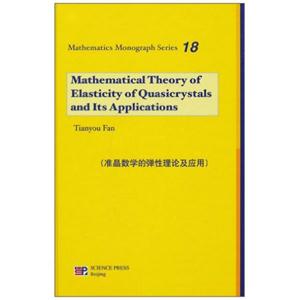-
>
宇宙、量子和人类心灵
-
>
考研数学专题练1200题
-
>
希格斯:“上帝粒子”的发明与发现
-
>
神农架叠层石:10多亿年前远古海洋微生物建造的大堡礁
-
>
二十四史天文志校注(上中下)
-
>
声音简史
-
>
浪漫地理学:追寻崇高景观
准晶数学的弹性理论及应用 版权信息
- ISBN:9787030256690
- 条形码:9787030256690 ; 978-7-03-025669-0
- 装帧:暂无
- 册数:暂无
- 重量:暂无
- 所属分类:>>
准晶数学的弹性理论及应用 本书特色
《准晶数学的弹性理论及应用(英文版)》:The dynamic and non-linear analysis of deformation and fracture of quasicrystals in this volume presents an innovative approach. It gives a clear-cut, strict and systematic mathematical overview of the field. Comprehensive and detailed mathematical derivations guide readers through the work. By combining mathematical calculations and experimental data, theoretical analysis and practical applications, and analytical and numerical studies, readers will gain systematic, comprehensive and in-depth knowledge on continuum mechanics, condensed matter physics and applied mathematics.
准晶数学的弹性理论及应用 目录
准晶数学的弹性理论及应用 节选
《准晶数学的弹性理论及应用(英文版)》内容简介:This inter-disciplinary work covering the continuum mechanics of novel materials, condensed matter phyics and partial differential equations discusses the mathematical theory of elasticity of quasicrystals (a new condensed matter) and its applications by setting up new partial differential equations of higher order and their solutions under complicated boundary value and initial value conditions. The new theories developed here dramatically simplify the solving of complicated elasticity equation systems. Large numbers of complicated equations involving elasticity are reduced to a single or a few partial differential equations of higher order. Systematical and direct methods of mathematical physics and complex variable functions are developed to solve the equations under appropriate boundary value and initial value conditions, and many exact analytical solutions are constructed.
准晶数学的弹性理论及应用 相关资料
插图:In general, the course of crystallography does not contain the contents given in this section. Because the discussion here is dependent on quasicrystals, especially with the elasticity of quasicrystals, we have to introduce some of the simplest relevant arguments.In 1900, Planck put forward the quantum theory. Soon after Einstein developed the theory and explained the photo-electric effect, which leads to the photon concept. Einstein also studied the specific heat c~ of crystals by using the Planck quantum theory. There are some unsatisfactory points in the work of Einstein although his formula explained the phenomenon of c~ = 0 at T = 0, where T denotes the absolute temperature. To improve Einstein's work, Debye[3] and Born et al. [4,5] applied the quantum theory to study the specific heat arising from lattice vibration in 1912 and 1913 respectively, and got a great success. The theoretical prediction is in excellent agreement to the experimental results, at least for the atom crystals. The propagation of the lattice vibration is called the lattice wave. Under thelong-wavelength approximation, the lattice vibration can be seen as continuum elastic vibration, i.e., the lattice wave can be approximately seen as the continuum elastic wave. The motion is a mechanical motion, but Debye and Born assumed that the energy can be quantized based on Planck's hypothesis. With the elastic wave approximation and quantization, Debye and Born successfully explained the specific heat of crystals at low temperature, and the theoretical prediction is consistent with the experimental results in all range of temperature, at least for the atomic crystals. The quanta of the elastic vibration, or the smallest unit of energy of the elastic wave is named phonon, because the elastic wave is one of acoustic waves. Unlike photon, the phonon is not an elementary particle, but in the sense of quantization, the phonon presents natural similarity to that of photon and other elementary particles, thus can be named quasi-particle. The concept created by Debye and Born opened the study on lattice dynamics, an important branch of solid state physics. Yet according to the view point at present, the Debye and Born theory on solid belongs to a phenomenological theory, though they used the classical quantum theory.
- >
唐代进士录
唐代进士录
¥15.1¥39.8 - >
经典常谈
经典常谈
¥16.3¥39.8 - >
伊索寓言-世界文学名著典藏-全译本
伊索寓言-世界文学名著典藏-全译本
¥9.3¥19.0 - >
二体千字文
二体千字文
¥16.8¥40.0 - >
有舍有得是人生
有舍有得是人生
¥16.7¥45.0 - >
人文阅读与收藏·良友文学丛书:一天的工作
人文阅读与收藏·良友文学丛书:一天的工作
¥19.2¥45.8 - >
苦雨斋序跋文-周作人自编集
苦雨斋序跋文-周作人自编集
¥6.9¥16.0 - >
莉莉和章鱼
莉莉和章鱼
¥16.4¥42.0
-
4.23文创礼盒A款--“作家言我精神状态”
¥42.3¥206 -
4.23文创礼盒B款--“作家言我精神状态”
¥42.3¥206 -
一句顶一万句 (印签版)
¥40.4¥68 -
百年书评史散论
¥14.9¥38 -
1980年代:小说六记
¥52.8¥69 -
中图网经典初版本封面-“老人与海”冰箱贴
¥20¥40




















